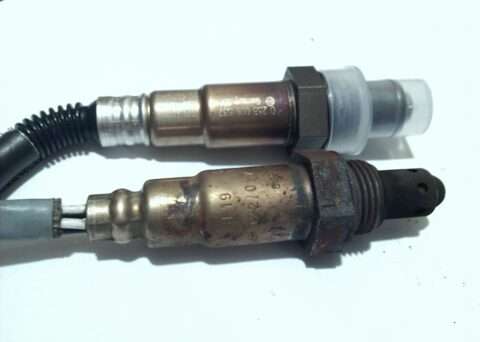
P0145 Slow response of oxygen sensor 3 (bank 1) to rich/lean
Content
P0145 – OBD-II Trouble Code Technical Description
Trouble code P0145 indicates slow response of oxygen sensor 3 (bank 1) rich/lean
What does the fault code mean P0145?
Trouble code P0145 is a general trouble code that indicates that the engine control module has detected that the oxygen sensor 3 (bank 1) circuit voltage does not drop below 0,2 volts for more than 7 seconds when the fuel is turned off in deceleration mode. car. This indicates that the oxygen sensor is responding too slowly.

Possible reasons
Some possible reasons for the P0145 trouble code:
- Defective oxygen sensor: Poor sensor quality or wear can cause the voltage to read incorrectly.
- Wiring Problems: Opens, shorts, or damaged wiring can cause the oxygen sensor to signal incorrectly.
- Connector Problems: Incorrect connection or oxidation of the oxygen sensor connector can cause poor contact and incorrect voltage reading.
- Malfunctioning ECM: Problems with the engine control module can cause the oxygen sensor signals to be misinterpreted.
- Exhaust System Problems: Improper functioning of the catalytic converter or other exhaust system components can result in incorrect oxygen sensor readings.
What are the symptoms of a fault code? P0145?
Symptoms for DTC P0145 may include the following:
- Engine performance deterioration: You may experience engine performance problems such as loss of power, rough running, shaking, or irregular idle speed.
- Increased fuel consumption: Increased fuel consumption may occur due to improper operation of the engine management system.
- Errors appearing on the instrument panel: Warning messages or Check Engine lights may appear on your dashboard.
- Idle speed instability: There may be problems with the idle, such as instability or unusual sounds.
- Uneven engine operation: The engine may run rough or rough even during normal driving.
It is important to note that symptoms may vary depending on the specific problem and the operating conditions of the vehicle.
How to diagnose a fault code P0145?
To diagnose DTC P0145, the following steps are recommended:
- Check for errors using a diagnostic scanner: Use a diagnostic scanner to read trouble codes and determine if P0145 is present.
- Check the oxygen sensor circuit: Check the oxygen sensor circuit for shorts, opens, or damage. Also check connections and contacts for corrosion or oxidation.
- Check the oxygen sensor: Check the condition of the oxygen sensor for wear or damage. Make sure the sensor is installed correctly and has no leaks.
- Check the operation of the engine management system: Check the operation of the engine management system, including sensors, valves and other components that may affect the operation of the oxygen sensor.
- Check the condition of the exhaust system: Check the exhaust system for leaks, damage, or other problems that could affect the performance of the oxygen sensor.
- Check software and updates: Ensure that the ECM software is current and does not require updates.
- Clean or replace the sensor: If necessary, clean or replace the oxygen sensor.
- Reset errors: Once the problem is resolved, reset the trouble codes using a diagnostic scan tool.
If you are unsure of your skills or experience, it is recommended that you contact a qualified auto mechanic for diagnosis and repair.
Diagnostic errors
When diagnosing DTC P0145, the following errors may occur:
- Misinterpretation of symptoms: Some symptoms, such as poor fuel economy or rough running of the engine, may be misinterpreted as signs of a bad oxygen sensor.
- Insufficient diagnosis: Some technicians may limit themselves to only checking the oxygen sensor itself, without considering other possible causes, such as problems with the power circuit or the engine management system itself.
- Incorrect sensor replacement: If undiagnosed or misdiagnosed, unnecessary replacement of the oxygen sensor may occur, which may not solve the problem.
- Skipping circuit and electrical connections checks: Failure to check the power supply and electrical connections may result in faulty diagnostics and unnecessary component replacement.
- Ignoring other possible causes: Some auto mechanics may focus only on the oxygen sensor, ignoring other possible causes such as fuel or air intake problems.
To avoid these errors, it is recommended to carry out a complete diagnosis, taking into account all possible causes, and check all relevant components before proceeding with replacement or repair.
How serious is the fault code? P0145?
Trouble code P0145, which indicates that oxygen sensor 3 (bank 1) is responding too slowly, is not typically critical to driving safety, but can result in poor fuel economy, poor engine performance, and increased emissions. If the problem is ignored, this can lead to further deterioration of the vehicle and increased fuel costs. Therefore, although this code is not urgent to repair, it is recommended that you contact a professional to diagnose and resolve the problem as soon as possible.
What repair will help eliminate the code? P0145?
To resolve DTC P0145, follow these steps:
- Checking the oxygen (O2) sensor: The first thing you need to check is the oxygen sensor itself. This includes checking its connections, wiring and functionality. If the sensor is found to be faulty, it must be replaced.
- Checking wiring and connections: Check the wiring and connectors connecting the oxygen sensor to the engine control module (ECM). Make sure that the wiring is not damaged and that the contacts are well connected.
- Checking the Engine Control Module (ECM): In some cases, the problem may be caused by a problem with the Engine Control Module (ECM) itself. Diagnose the ECM to determine its condition.
- Checking the air and fuel filters: Irregular air and fuel mixing can also cause P0145. Check the air and fuel filters for dirt or blockages.
- Checking the exhaust system: Check the condition of the exhaust system for leaks or damage that could cause the oxygen sensor to not read correctly.
- Code Cleanup and Testing: After repairing or replacing the oxygen sensor, you must clear the DTC from the ECM and test the vehicle to ensure that the problem has been successfully resolved.
If the problem persists after following these steps, it is recommended that you contact a professional auto mechanic for more detailed diagnosis and repair.
P0145 – Brand-specific information
Information about the P0145 trouble code may vary slightly depending on the vehicle make and model. Below is a breakdown of the P0145 code for some specific brands:
- Toyota / Lexus: Insufficient response time of oxygen sensor 3, bank 1 (voltage does not drop below 0,2 V for more than 7 seconds during fuel cut).
- Honda/Acura: Insufficient response time of oxygen sensor 3, bank 1 (voltage does not drop below 0,2 V for more than 7 seconds during fuel cut).
- Nissan/Infiniti: Insufficient response time of oxygen sensor 3, bank 1 (voltage does not drop below 0,2 V for more than 7 seconds during fuel cut).
- Ford: Insufficient response time of oxygen sensor 3, bank 1 (voltage does not drop below 0,2 V for more than 7 seconds during fuel cut).
- Chevrolet / GMC: Insufficient response time of oxygen sensor 3, bank 1 (voltage does not drop below 0,2 V for more than 7 seconds during fuel cut).
This is general information only and for each make and model of vehicle it is recommended that you consult the appropriate technical manual or consult a mechanic for more detailed information.
